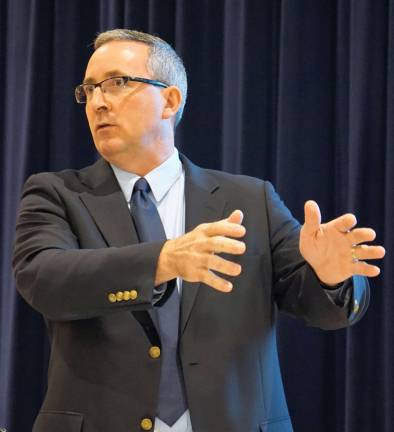Speaker discusses opioid epidemic


VERNON — The Vernon Coalition hosted, June 14, guest speaker Drug Enforcement Administration (DEA) Special Agent Timothy P. McMahon to discuss the Prescription Opioid/Heroin Epidemic and DEA 360 Strategy. The DEA is a federal agency — part of the Department of Justice.
McMahon reminded, “We're not going to arrest our way out of this problem.” He added, even if they arrest thousands of people, someone will take their place in the multi-billion dollar industry. Drug cartels, he explained, run the drug industry like fortune 500 companies with: production, manufacturing, logistics, transportation, and distribution.
In 2015, McMahon said, over 52,000 people overdosed and died from all drugs – about the number of people in a sold-out Yankee Stadium. Of those 52,000, 33,000 were directly related to prescription opioids or heroin.
He continued, 80 percent, 4 out-of-5, of new heroin users started with an addiction to prescription pain pills. McMahon showed comparative molecular models of Oxycontin (Oxycodone) and heroin — virtually identical.
“That's why,” he continued, “there is such an easy transition of people addicted to the pills, shooting straight over to heroin. It affects the brain in the exact same way — same exact pain receptors.”
Statistically, McMahon said, 53 percent is obtained free from a friend or relative; 21 percent from a doctor's prescription; and 14 percent bought/taken from a friend or relative. In the past, patients received a 20–to–30-day supply from a doctor and stuck the unused pills in the medicine cabinet.
Since New Jersey recently passed legislation requiring doctors to only initially prescribe a five day period, McMahon said, “Hopefully over time, we will see a reduction in the amount of available pills that have been left around.”
He said teens think prescription pills are safer than heroin, cocaine, and methamphetamine, because a doctor wrote a prescription, each tablet says 30 mg, and it was picked up at a pharmacy.
In order to bring in new customers, cartels press pills mixing heroin and Fentanyl, to make them look like Oxy. The new high is so good, the user goes straight to heroin.
New Jersey has the purest heroin in the country, McMahon said, — on average 58–63 percent purity level, compared to 10–to–15 percent elsewhere. McMahon explained, New Jersey is a hub where heroin arrives, so drug cartels do not need to “cut” the bulk heroin by adding: ground up drywall, rat poison, meat tenderizer, baby formula, or Fentanyl.
He said a cluster of overdoses usually happens in a particular area because the heroin and Fentanyl were not mixed correctly. Surprisingly, the overdoses bring more users to the area to experience such a good high. They assume they will not overdose.
The New Jersey Good Samaritan Act, he reminded, prevents arresting a caller reporting a drug overdose.
Drug users, he said, think Narcan — used to reverse the effects of drugs is a safety net. He said, “Depending on how much they take, and what's in it, Narcan may not be effective.”
He reviewed the DEA 360 strategy: enforcement — federal, state, and local levels, diversion control - regulatory, and community - outreach, education, and prevention.
After October, he explained, the DEA will designate Newark and the Philadelphia/Camden area as 360 cities. Then the DEA will flood the areas with advertising, talking about the problem, and directing people to treatment.
The DEA also completes large investigations in housing projects for six–to–eight months. He said, as they are ready to arrest, they bring all the area coalitions: boys' and girls' clubs, YMCA, and other community resident and kid programs to replace the drug problem.
He added the DEA goes after dirty doctors and dirty pharmacists — the one percent who give doctors and pharmacists a bad name. In addition, they, and many police departments, have permanent drop boxes for unused medications.
As part of the DEA education and outreach, McMahon presented to the Vernon Coalition.